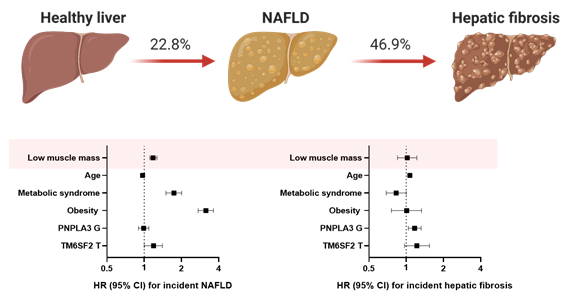Inside Labs
Inside Labs
A Role of Low Muscle Loss in the Natural History of Non-Alcoholic Fatty Liver Disease
Update 23.03.2023
20 November 2022
A Role of Low Muscle Loss in the Natural History of Non-Alcoholic Fatty Liver Disease
New Study Finds Low Muscle Mass Plays a Different Role in Developing Non-Alcoholic Fatty Liver Disease and Hepatic Fibrosis
A new study has found that low muscle mass can independently contribute to the development of non-alcoholic fatty liver disease (NAFLD). NAFLD is a condition in which fat accumulates in the liver, and it is associated with metabolic abnormalities such as insulin resistance and obesity. Although sarcopenia, a condition characterized by the loss of muscle mass and strength, has been linked to NAFLD, it is challenging to determine whether sarcopenia itself contributes to the development of the disease or whether it is the result of metabolic derangements.
In a community based prospective cohort study conducted in the Korean population, researchers investigated the contribution of low muscle mass to the development of NAFLD and NAFLD related hepatic fibrosis with adjustment for confounders including genetic risk factors. The study discovered that both low muscle mass and genetic risk variants are significant contributors to the development of NAFLD. The incident rate of hepatic fibrosis also showed an inverse relationship with muscle mass at baseline; however, it lost its statistical significance after adjustment for confounders. Old age and genetic factors were independent risk factors for the development of hepatic fibrosis.
The genetic component plays a significant role in an individual’s susceptibility to liver disease. The study found that the genetic polymorphism of PNPLA3 and TM6SF2 increased the vulnerability to NAFLD and NAFLD-related hepatic fibrosis.

Fig 1. The role of low muscle mass in the risk of developing NAFLD and NAFLD-related hepatic. There was a difference in the risk factors between developing NAFLD and progression to hepatic fibrosis. Both low muscle mass and genetic risk variants were important contributors to the development of NAFLD. In patients already diagnosed with NAFLD, however, PNPLA3 conferred a greater risk for hepatic fibrosis progression than did lower muscle mass.
This study's findings provide new insights into the complex interplay of genetic and environmental factors that influence the development of NAFLD and hepatic fibrosis. With further research, this knowledge could help develop personalized prevention and treatment strategies for individuals at risk of liver disease.
In conclusion, low muscle mass can independently contribute to the development of NAFLD, and genetic risk factors increase vulnerability to NAFLD-related hepatic fibrosis. The study's findings highlight the importance of considering both muscle mass and genetic risk factors when assessing the risk of liver disease.
Reference
* Author: Hun Jee Choe, Hyunsuk Lee, DongHo Lee, Soo-Heon Kwak & Bo Kyung Koo
* Title: Different effects of low muscle mass on the risk of non-alcoholic fatty liver disease and hepatic fibrosis in a prospective cohort
* Journal: Journal of Cachexia, Sarcopenia and Muscle
* Published date: 20 November 2022
* DOI: https://doi.org/10.1002/jcsm.13125
Funding
* This study was supported by Korea National Institute of Health (2022ER090700).
About National Institute of Health in Korea
The Korea National Institute of Health (KNIH), one of the major operating components of the Ministry of Health and Welfare, leads the nation’s medical research. Over the past seven decades, the KNIH has made unwavering efforts to enhance the public’s health and innovate biomedical research. The KNIH seeks to eradicate diseases and make people healthier. The KNIH establishes a scientific basis and evidence underlying health policy as well as provides national research infrastructures. We also promote public health research. To this end, we make efforts to enrich a health research environment by granting funds to research projects and keeping our resources, data, and facilities more open and accessible to researchers.
Website: https://nih.go.kr/eng/main/main.do

